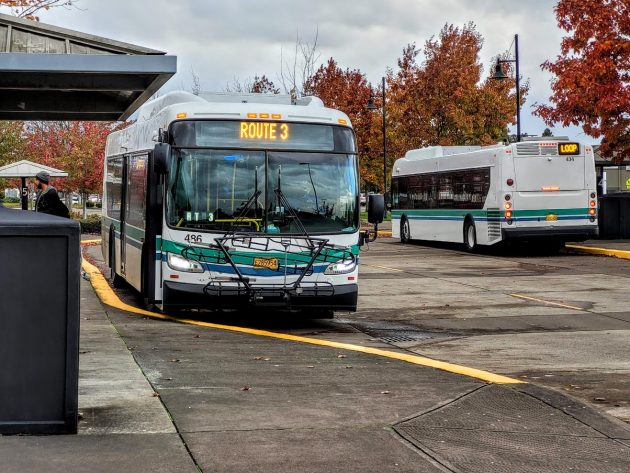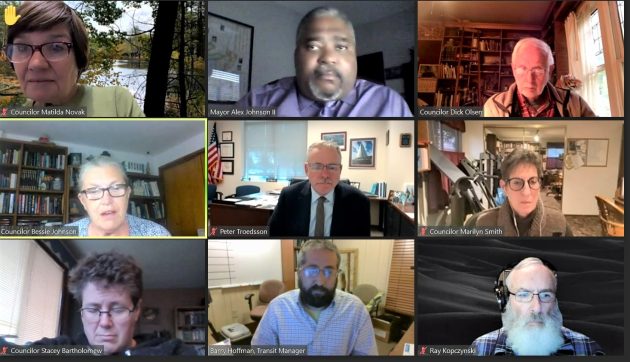
The Route 3 bus of ATS stops at Albany Station at 5:19 on Tuesday night.
Albany’s city bus system is poised to double in the number of buses and routes. But the hours of operations will remain the same, 6:30 a.m. to about 7 p.m. Monday through Friday. No buses on Saturday or Sunday.
Transit Manager Barry Hoffman gave the city council a rundown of the changes on Monday. New routes and schedules are expected to begin this coming winter, but steps still have to be taken before a date can be set.
Bus stops still have to be moved or built, for one thing. Drivers have to be hired and shifts arranged, for another.
With grant money, the city has bought two 35-foot New Flyer buses for a total of a little more than $1 million.
Since the 1980s, the Albany Transit System has operated two main circular routes. After the change there will be four on which buses will go back and forth.
Instead of two buses in daily operation, there will be four. They will log 48 hours of service per day, up from 20 now. This will require the full-time equivalent of 5.5 drivers, up from 2.5.
What’s all this going to cost? About $1.4 million in fiscal 2021-22, compared to about $800,000 in fiscal 2019, the last year before Covid-19.
But the council won’t have to worry about it. The entire operation is funded by grants from the Federal Transit Administration and the Statewide Transportation Improvement Fund, which is fed by the 0.1 percent Oregon payroll tax enacted by the legislature in 2017.
Passengers won’t have to worry about it either. As long as the pandemic lasts, rides on the ATS buses are free. Before they were free, they cost a dollar for adults, 50 cents for seniors, and nothing for kids under 6.
How many riders are there? Hoffman didn’t say except to report that the number has plummeted during the pandemic. Before then, he said, the system’s cost was about $5 per ride. (The city’s 2020 comprehensive annual financial report showed about $34,000 in fare revenue. If each passenger paid a buck, you can see how many there would have been.)
Hoffman showed the council a map of the new routes, but I couldn’t read them. Among the changes he mentioned: The North Albany bus will turn around at the park-and-ride off Hickory Street and will no longer go up Gibson Hill to Fire Station 14. A route on Waverly Drive will no longer go as far south as Del Rio. But there will be better service, Hoffman said, to South and West Albany high schools in response to a shortage of school bus drivers.
He mentioned an app that tracks where Albany buses are on their routes in real time, and when they will reach each stop. I used the app to catch a photo of a bus at Albany Station on Tuesday night. Sure enough, the bus on Route 3 arrived at 5:18, exactly when the app said it would.
A handful of people got off, and some waited a couple of minutes for Route 2 to arrive. Then they boarded that bus to continue their trip.
Hoffman is planning a publicity drive to let people know about the improved system weeks before it actually starts. That will give transit riders a chance to figure out way in advance how they can use the bus to go where they need to go when. (hh)

The council listens to Transit Manager Barry Hoffman, in the middle of the bottom row, on Monday.

Woohoo, free government money!!
Oh…what’s that you say?….the money comes from the statewide transit tax imposed on the wages of each employee? Is that the number in Box 14 of the W-2?
So every Albany resident who works is forced to pay for this?
And it’s a flat tax, meaning every paycheck earner pays the same rate regardless of income?
Doesn’t that make the tax regressive? Having a greater impact on lower-income individuals than the higher-income individuals?
And just a few folks, regardless of income, will use this expanded bus service?
But hey…about 30% of us don’t work, so we’re figmo on this tax.
Enjoy that “free” bus ride.
For a minimum wage worker working full-time, the cost of the tax is about $10.00 for the entire year. It’s costs more to pay into the WBF, but I don’t hear you whining about that.
The simple fact is, folks need to quit expecting/demanding that the ‘rich’ keep funding their choices. The US has been, and STILL IS, the land of opportunity. If you have any doubts about that, just ask all the folks that are waiting to immigrate.
What ATS needs, and will increase their ridership…is buses that go in both directions.
As I think my story said, on the new routes the buses WILL go in both directions.
Out of curiosity…… how long is the grant good for for operations? I would hate to see a 1-3 year grant and then the city required to pick up the tab to sustain operations. Although the extra service is “free” why are we expanding a service that has been dying in recent years?
Why expand? The intent, I’d pretty sure, is to make the bus system more useful to more people. Two goals: Help people who have no private transportation, and entice more people to take the bus instead of their cars for trips around town.
Running the buses more frequently could do far more to get people ride them. My wife took a course at LBCC. She really wanted to take the bus to and from our home in Albany, but if she did she would have been 20 minutes late every day, and dismissed from the program. So she had to drive.
I don’t know many people that can regularly show up late for classes, jobs, appointments or meeting. No one I know wants to have to arrive and kill 20-40 minutes before they start or have to waste another 20-40 minutes waiting for a bus when we are done. If the city can’t figure out running them more often, they could, at the bare minimum, arrange for the buses to arrive and depart the higher use locations (LBCC, High Schools, Larger employers, etc.) at convenient times. How many people do you know that are willing to add an hour of WAITING into their daily commute?
More buses on more routes is not necessarily the solution. Running the routes we have more frequently with additional buses might do a lot more for ridership.
Right there with you. If it takes double or more time from origin to destination than it does to drive most people are not going to take the bus regardless of cost, free or otherwise.
Ahh yes….Convenience and Reliability.
That will boost ridership.
Does the bus make a run out Spring Hill? I have never seen one out that way.
It seems to travel North Albany Rd to Gibson Hill then west to the Fire station and return.
Just as in other areas of Albany it is not convenient, nor close enough, for the older or disabled residents to use. Not the most pleasant to have to walk, and carry groceries for long distances in the rain.
It’s a catch 22 – weigh cost (Cost, fuel, maintenance, labor and associated costs) vs convenience. No matter where you live, smaller cities or large, some people just are nor served by mass transit.
Before WalMart, the #2 bus used to stop by the old city hall with the #3 bus stopping in the same place about 20 minutes later. This allowed me to be back at my “home bus stop” ONE hour later for about 90% of my downtown business. NOW, it’s a 2 hour trip and I go to the much more convenient heritage Mall/Fred Meyer. I only go downtown when absolutely necessary. I’m not even sure WHERE the bus stops downtown anymore because it’s been so long. Maybe if you had better bus service downtown, you wouldn’t have to keep dumping CARA money into this rathole.
We have good City government except our bus system is worthless. I meet busses all day and usually they are EMPTY. The Council goes on with it because the US pays almost all the cost. I spoke to the City Mgr about it. I think we should go EV or something because we are spewing more diesel fumes in the air than we are serving citizens.
Too bad they couldn’t get electric buses. That’s what Biden wants.
The electric buses being built today are really cool. Check out Proterra. Over the life of the bus they often save operators $400,000-$600,000 per bus due to lower electric costs and lower maintenance costs versus gas engines. I can’t wait for the infrastructure bill to pass. We definitely need work on our roads, rails, and transit to give people options to get around and to save time and money on commutes and travel.
Information as to what the new routes will look like (and why) were presented at our work session. It starts ~28 minutes into the meeting:
https://www.youtube.com/watch?v=n5b9-4fT6LI
Why isn’t Albany using one of the buses to do a night run 7-10pm weekdays and a limited weekend run? Not everyone works a M-F 8-5 job and people need transportation options. Ridership might be lower off hours but those riders are the ones that really need reliable transportation.
Any improvements come at a cost. I believe the major changes already planned will add to ridership simply because of the improved on-time connections happening more often. Can more still be added? Possibly, but we first have to see how the current improvements shake out IMO.
Eliminating the stop from the Boys & Girls Club is STUPID!